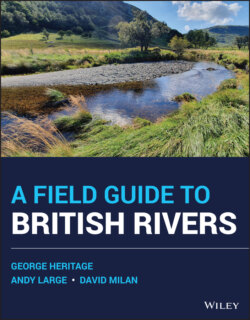Читать книгу A Field Guide to British Rivers - George Heritage - Страница 20
2.3.2 Process‐Based Classification of Montgomery and Buffington (1997)
ОглавлениеThe 1997 classification identifies eight functional river types based on discriminatory values of degree of confinement, system gradient, bedform types and spacing, bed material, reactivity, and sediment source and storage character (Table 2.1). It should be noted that the channel types and control variable limits defined in both Montgomery and Buffington and in Leopold and Wolman (above) are by no means universal, and this is illustrated in Table 2.2 which summarises several other typologies developed for alluvial channels.
Figure 2.1 River types on the sediment supply continuum.
Figure 2.2 Channel type change with river gradient, sedimentology, and discharge
(Source: Based on Leopold and Wolman (1957). © John Wiley & Sons).
Table 2.1 River types identified by Montgomery and Buffington (1997) along with their key attributes.
Source: Modified from Montgomery and Buffington (1997). © John Wiley & Sons.
| Attribute | Channel type | |||||||
|---|---|---|---|---|---|---|---|---|
| Braided | Regime | Pool‐riffle | Plane‐bed | Step‐pool | Cascade | Bedrock | Colluvial | |
| Typical bed material | Variable | Sand | Gravel | Gravel cobble | Cobble boulder | Boulder | n/a | Variable |
| Bedform pattern | Lateral oscillation | Multi layered | Lateral oscillation | None | Vertical oscillation | None | Variable | |
| Reach type | Response | Response | Response | Response | Transport | Transport | Transport | Source |
| Dominant roughness elements | Bedforms (bars, pools) | Sinuosity bedforms (dunes, ripples, bars) Banks | Bedforms (bars, pools) Grains Large wood Sinuosity Banks | Grains, Banks | Bedforms (steps, pools) Grains Large wood Banks | Grains Banks | Boundaries (bed, banks) | Grains Large wood |
| Dominant sediment sources | Fluvial Bank failure Debris flows | Fluvial Bank failure Inactive channel | Fluvial Bank failure Inactive channel Debris flows | Fluvial Bank failure Debris flows | Fluvial, Hillslope Debris flows | Fluvial Hillslope Debris flows | Fluvial Hillslope Debris flows | Hillslope Debris flows |
| Sediment storage elements | Overbank bedforms | Overbank bedforms inactive channel | Overbank bedforms inactive channel | Overbank inactive channel | Bedforms | Lee and stoss sides of obstructions | Bed | |
| Typical slope | <0.03 | <0.001 | 0.001> <0.02 | 0.001> <0.03 | 0.03> <0.08 | 0.08> <0.3 | Variable | >0.2 |
| Typical confinement | Unconfined | Unconfined | Unconfined | Variable | Confined | Confined | Confined | Confined |
| Pool spacing (channel widths) | Variable | 5–7 | 5–7 | none | 1–4 | <1 | Variable | Variable |
Table 2.2 Additional river types to those listed in Table 2.1, with channel slope as a discriminator.
| Reference | Pool | Glide | Riffle | Rapid | Cascade |
|---|---|---|---|---|---|
| Bisson et al. (1988) | S < 0.04 | S > 0.04 | S > 0.04 S < 0.16 | ||
| Sullivan (1986) | S < 0.01 | S > 0.01 S < 0.02 | S > 0.01 S < 0.04 | S > 0.04 | S ~ 0.068 |
| Grant et al. (1990) | S ~ 0.005 | S < 0.02 | S ~ 0.011 | S ~ 0.029 | S ~ 0.055 |
| Wood‐Smith and Buffington (1996) | Closed topographic depression | S > 0.02 S < 0.04 | S > 0.04 | ||
| Montgomery and Buffington (1997) | S ~ 0.012 | S > 0.0015 S < 0.04 | S > 0.02 S < 0.076 | S ~ 0.11 |
Figure 2.3 The River Styles typology
(Source: Based on Brierley and Fryirs (2005). © John Wiley & Sons).
